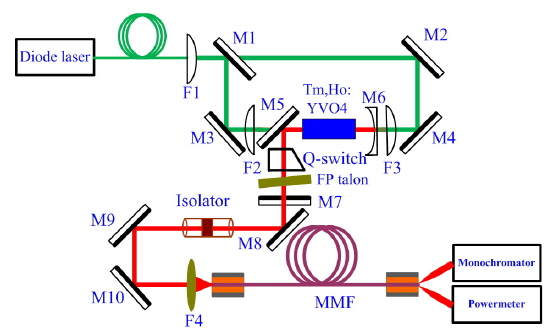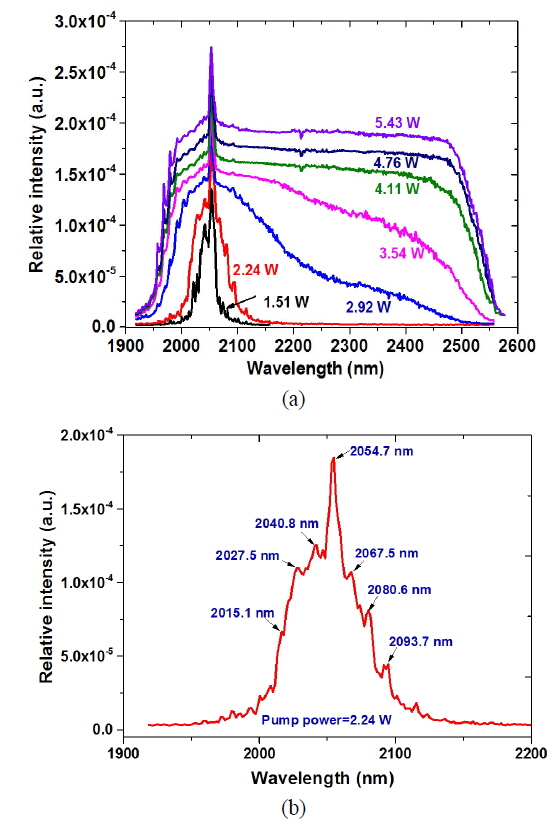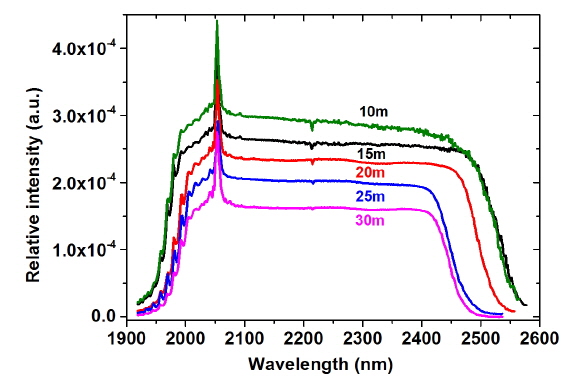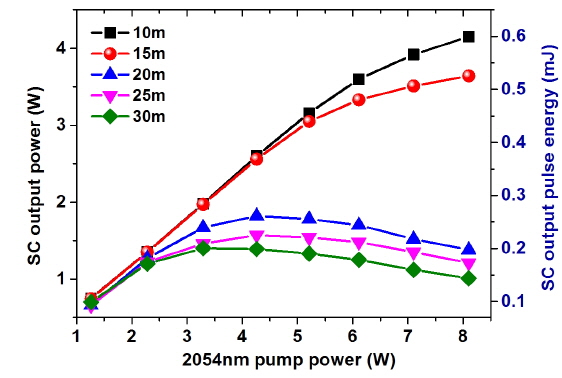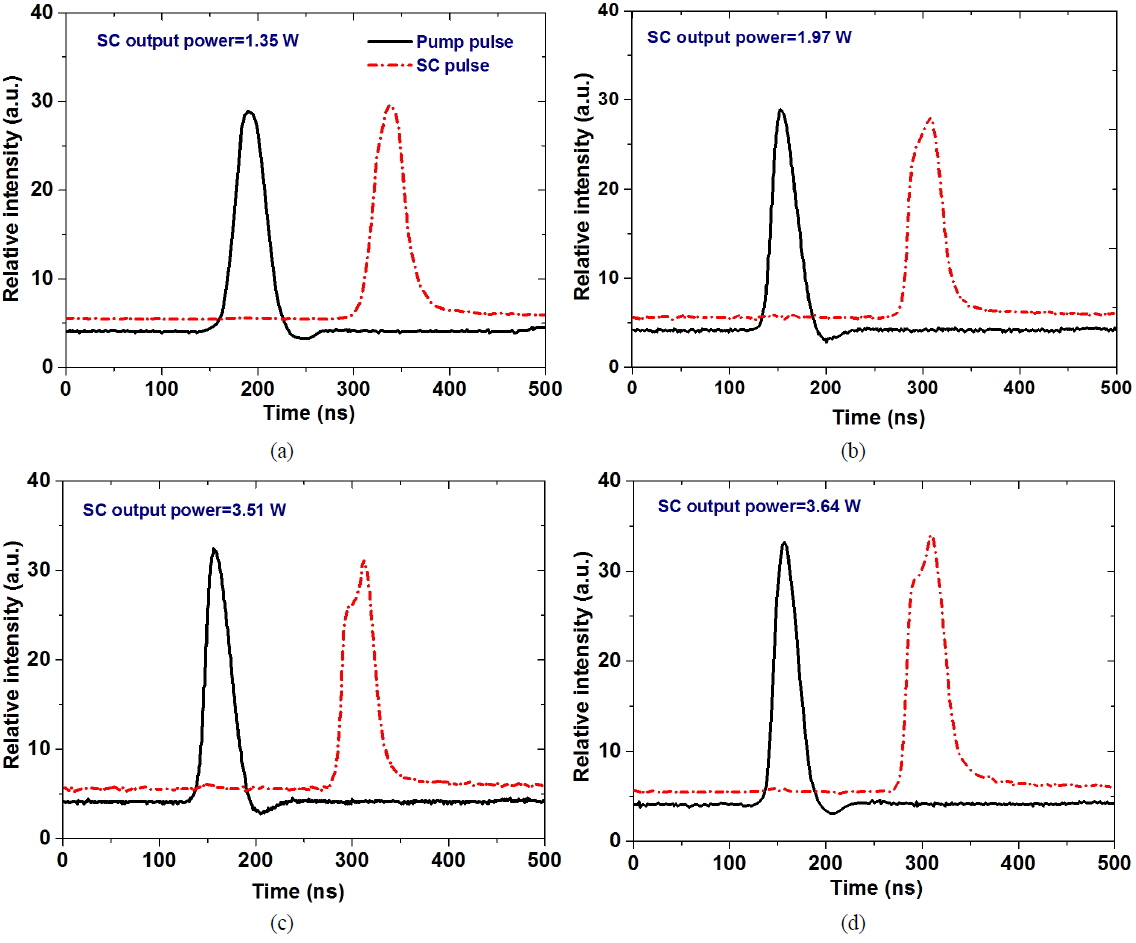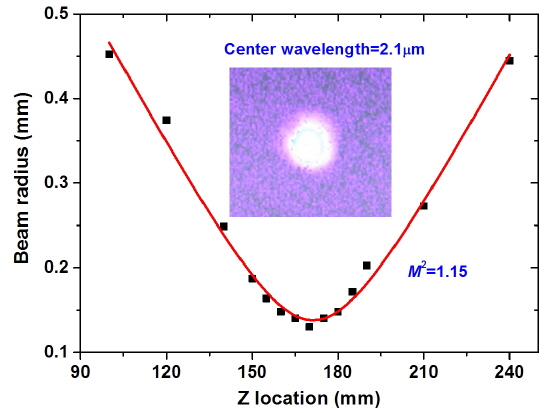



SC generation in optical fibers has been the subject of extensive research in recent years due to the great fundamental interests and its potential applications in atmosphere analysis, spectroscopy, free-space communications, biology and medicine [1-5], especially in the mid-IR spectral region. With the recent development of various special optical fibers, including microstructure fibers (MF) [6, 7], fiber tapers [8], highly nonlinear fibers (HNLF) [9, 10], fluoride fibers [11-13], tellurite fibers, and chalcogenide fibers, broadband SC source can be efficiently generated by pumping with high power pulsed lasers (femtosecond, picosecond, and nanosecond pulses) or even with continuous-wave lasers.
Through consulting the literature related to this topic, it is worth noting that most pump sources used to obtain the SC are mode-locked lasers or short pulse amplifiers [14], and high peak power can be achieved easily. However, the intrinsic construction of these lasers limits the output energy, with the result that it is difficult to obtain broadband SC source with high output energy. This may be an obstacle for some applications requiring sufficient brightness of broadband sources, such as an up to 25.7 W power scalable TDFA-based SC laser spanning from ~2 to 2.5 μm that was recently demonstrated by Alexander et.al. [15]. When the power of the SC laser got to maximum, the pulse repetition rate was ~1.1 MHz, and the pulse energy was only ~23.4 μJ. Additionally, due to the short pump pulses and the high nonlinearity in the special fiber, the output time-domain pulse is always broken up into a series of shorter pulses, and the pulse energy is dispersed. Furthermore, most literature concerns SC generation in all kinds of special fibers which are mentioned in the above paragraph, less attention has been paid to SC generation in the mid-IR range with use of the cheap and widely commercially available telecommunication MMF pumped by ≥ 2000 nm nanosecond pulse solid laser. Previously, standard SMF or MMF was used to generate mid-IR SC laser pumped by ~1550 nm pulse fiber laser or amplifier [16, 17]. In this year, we reported a SC generation in standard SMF pumped by 2054 nm pulse laser, and the obtained maximal power was 0.53 W at 7 kHz [18]. However, when the SMF was used as the nonlinear medium, it possesses two disadvantages. (1) The damage threshold of the SMF facet was low (the maximum coupled power was 1.53 W [18]), which limits the output pulse energy. (2) The coupling efficiency of the pump laser was low; the main reason can be attributed to the only ~8 μm core diameter.
In this paper, a conventional telecommunication MMF instead of a standard SMF was used in the experiment, and we have demonstrated a 0.52 mJ SC laser generation in MMF pumped by a nanosecond Q-switched Tm,Ho:YVO4 laser, which is the highest SC laser output energy reported in this spectral range, to our knowledge. To pump the SC laser we have used a Q-switched Tm,Ho:YVO4 laser emitting at 2.054 μm, and the maximum output power is ~8.1 W at 7 kHz pulse repetition rate. The output wavelength of the SC laser is >1900 nm, and the maximum achieved average SC power is 3.64W.
The experimental setup of SC generation in telecommunication MMF pumped by a nanosecond Q-switched Tm,Ho:YVO4 laser is shown in Fig. 1. The fiber coupled laser diodes with maximal output power of 35 W were used as the pump source, and the emitting wavelength was in the range of 798-802 nm. The diameter of output coupler fiber was 400 μm, and the numerical aperture (NA) was 0.22. The resonator cavity of the Tm,Ho:YVO4 laser was a plano-concave structure, and was formed by M5, M6 and M7. M5 was a 45° dichromatic mirror with high-reflectivity (HR) (≥99.5%) at ~2.05 μm and anti-reflection (AR) (≥90%) at ~800 nm. M7 was a flat mirror with 40% transmission in wavelength range of 1.9-2.2 μm. F1 was a coupling lens, and the focal length was 25 mm. F2 and F3 were mode matching lenses, and the focal lengths were 50 mm. M1 was a 45° dichromatic mirror with partial reflectivity of 50% at around 800 nm. M2, M3 and M4 were 45° dichromatic mirrors with HR (≥99.5%) at ~800 nm. The Tm,Ho:YVO4 bonding crystal for the experiment was a-cut with dimensions 3×3 mm2 in cross section and 8 mm in length. The ion dopant concentrations were 4 at% Tm3+, 0.4 at% Ho3+. Both end faces of the crystal were coated with AR at ~2.05 μm laser wavelength and ~800 nm pump wavelength. The Tm,Ho:YVO4 crystal was placed in the vicinity of the F2 and F3 lens focus. The confocal spot of 800 nm pump laser, inside of the laser crystal, was measured, and the diameter was ~0.75 mm. The laser crystal was wrapped in indium foil and mounted on a copper heat-sink and placed in a dewar which is used as the liquid nitrogen reservoir. The acousto-optical Q-switch used in the experiment was the same as in the literature [19]. To achieve a single wavelength operation, a 0.1mm Fabry-Perot etalon was also inserted into the optical path, and the 2.054 μm output laser wavelength was selected. M8, M9 and M10 were a 45° dichromatic mirror with HR (≥97% ) at 2.05 μm laser and AR (≥90%) at around 800nm pump laser. The telecommunication MMF used in the experiment had graded refractive index profile and the core/clad diameter of 50/125 μm. The double ends of MMF were perpendicular cleaved, and clamped in a copper heat-sink. The output 2.054 μm laser was coupled into MMF core by a focusing lens F4 (f=9 mm), and the measured coupling efficiency was ~70%. In order to prevent Tm,Ho:YVO4 pump laser from being influenced by the fiber end feedback and the nonlinear laser (SBS), an optical isolator was placed into the pump path.
The output characteristics of Q-switched Tm,Ho:YVO4 laser were shown clearly in the literature [18]. Spectral measurements were acquired using a monochrometer (300 mm focal length, 600 lines/mm grating blazed at 2.0 μm), an InGaAs detector covering the spectral band of 1.2-2.6 μm, and an SR830 lock-in amplifier which was used to extract signal. The spectrum evolution of the SC laser was illustrated in Fig. 2 (a). The injected average pump powers increased from 1.51 to 5.43 W, which correspond to the peak power of 7.29 to 34.42 kW. Here we estimate the peak power of 2.054 μm laser pulses by considering the coupling efficiency, pulse width (~40 to ~21 ns), and pulse repetition rate. The telecommunication MMF used in the experiment had a length of 15 m. Note that the spectral width is set by the pump power. A weak SC spectrum was observed at 1.51 W, and the spectrum broadening was inconspicuous. While scaling up 8.1 W pump power, at which the MMF fiber facet may be damaged, the SC spectrum extends from ~1920 to ~2575 nm, and the output spectrum had excellent flatness in the wavelength interval of ~2070 to ~2475 nm with negligible intensity variation (<2%). The underlying physical mechanisms responsible for SC generation in MMF are the modulation instability (MI), which plays an important role in the initial stage of SC generation, and the soliton self-frequency shifting caused by Raman scattering, which leads to the SC spectra shift toward the long-wavelength side [20]. The symmetrical MI spectral side bands can be clearly found when the pump power was 2.24 W, seeing the Fig. 2 (b). The harmonic wavelengths were 2015.1, 2040.8, 2067.5, 2080.6, and 2093.7 nm, and the sidebands were separated by ~13.1 nm from 2054.4 nm pump laser. The frequency shift of the MI gain peaks from the pump laser can be calculated by Δ
At pump power of 4.76 W, the spectral evolutions of the SC laser were studied for different MMF lengths, and are shown in Fig. 3. As can be seen from the figure, the width of the SC spectrum was broadened from ~455 nm to ~559 nm when the MMF length was cut back from 30 m to 10 m, and the long-wavelength edge of the SC spectrum was increased from ~2500 nm to ~2600 nm along with an increase of spectral density (The estimated average spectral power is from 2.3 mW/nm to 6.2 mW/nm.) in the overall wavelength range. It indicates that the wide spectrum is generated by the nonlinear processes within the first few meters of the MMF, and the spectrum is merely attenuated when it propagates through the longer length due to the high loss associated with the silica glass absorption beyond 2.4 μm [20]. However, when the MMF length was cut down to 10 m, the SC spectrum width was reduced to ~546 nm, and the spectral flatness of the long-wavelength region was downgraded, This illustrates that when the MMF length is less than 10 m, a higher pump power is needed to enhance the spectral flatness. Thus, in order to obtain the broadest spectrum under a certain pump power, an appropriate fiber length is indispensable
The average output power of the SC laser was measured by a power meter (Coherent, PM30) with thermal sensor response range of 0.15-11 μm, covering the entire SC spectral band. The average power of the SC laser as a function of pump power in different MMF lengths was shown in Fig. 4. As can be seen, for pump power of 5.43 W, the obtained output SC power, including the residual pump power at 2054 nm, increased from 1.01 to 4.15 W (the corresponding pulse energy increased from 0.14 to 0.59 mJ) by reducing the fiber length from 30 to 10 m, and the corresponding optic-to-optic conversion efficiency increased from 18.6% to 76.4% by considering the coupling efficiency. The increase of SC power can be attributed to the decrease of power loss in SC long-wavelength (>2.4 μm), while the MMF length was cut down. Since the SC long-wavelength edge was limited by the loss in the MMF, the spectral components in the vicinity of the long-wavelength edge generated by the additional pump power were heavily attenuated by the multiphonon absorption in silica fiber, so the output SC powers began to saturate or even decrease at 5.43 W pump power when the MMF length increased from 10 to 30 m. In other words, despite the fact that more long-wavelength spectral components could be generated by the pump power, they were not observed at the MMF output end (Seen in Fig. 4). Therefore, the SC laser should be operated in an appropriate fiber length to counterpoise the output power and the SC spectrum under a certain pump power. At 4.76 W pump power, the 15 m fiber length is thought to be an appropriate choice.
A fast InGaAs photodiode (rise/fall time <1ns) and a 350 MHz digital oscilloscope (WaveJet 332, LeCroy) were used to measure time-domain SC pulse duration. The typical temporal profile of the SC pulses at different output powers are shown in Fig. 5. At 1.35 W and 1.97 W output power, the time-domain SC pulses were stable and exhibited a similar single pulse shape. When the output SC power increased up from 3.51 W to 3.64 W, the pulse width was broadened from ~36 ns to ~43 ns, and pulse distortion phenomenon was found. The main reason could be attributed to the MI effect which was involved in the SC generation. However, the SC pulse was not broken into a train of multiple pulses, and the pulse energy was not dispersed.
In order to evaluate the beam quality of the SC spectrum, the output SC laser was passed to a 45° dichromatic mirror with HR (≥90% ) at ~2.1 μm. The separated SC laser was then focused by an f=150mm coated lens, and the intensity profile of the laser beam was measured at different axial positions around the focal spot by using a 90/10 knife-edge cutting across the beam. Figure 6 shows the measured beam radius at different positions after the lens. By fitting the Gaussian beam propagation profile to these data, the beam quality was estimated to be
In summary, we have demonstrated for the first time a ~0.52 mJ mid-IR SC laser based on telecommunication MMF directly pumped by nanosecond Q-switched Tm,Ho:YVO4 laser. The SC spectrum spreads in the mid-IR spectral band from ~1920 to ~2575 nm and is characterized by a high flatness spectrum distribution of the intensity (<2%) in the wavelength interval of ~2070 to ~2475 nm. For pump power of 5.43W, the maximum achieved average power of up to 3.64 W from the 15 m long MMF was obtained. The near-diffraction-limited SC laser beam is monitored by an infrared vidicon camera, and the estimated beam quality

